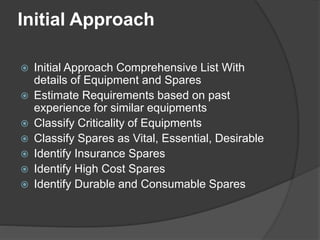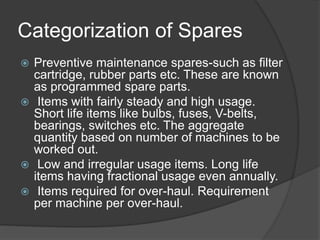Spare parts control for maintenance purposes
- 1. SUBMITTED BY: HIMALAYA KANWAR 1144834 D4 ME SEC B
- 2. Typical Characteristics of Spares ŌĆó Large in numbers and varieties ŌĆó Absence of Specifications ŌĆó Erratic consumption / No pattern ŌĆó Sourcing constraint ŌĆó High Prices High / non moving Inventory due to above parameters ŌĆó Requirement of Large Space and preservation ŌĆó Difficult to dispose off
- 3. Initial Approach ’é× Initial Approach Comprehensive List With details of Equipment and Spares ’é× Estimate Requirements based on past experience for similar equipments ’é× Classify Criticality of Equipments ’é× Classify Spares as Vital, Essential, Desirable ’é× Identify Insurance Spares ’é× Identify High Cost Spares ’é× Identify Durable and Consumable Spares
- 4. Inventory management ’é× Decide Frequency for review of Spares for critical Equipments ’é× Based on VED classification and cost of Spares, decide optimum safety stocks ’é× Fix min, max and reorder levels for consumable spares ’é× For durable spares, MRP data to be reviewed by competent engineers to assess requirements ’é× Insurance spares requirement to be initiated by user and reviewed at high levels ’é× Preservation plan and activity to be chalked out for durable and insurance spares
- 5. Operational Approach: Adopt Standardization as follows : ’é× Use Standard drives and couplings ’é× Use standard fasteners with maximum interchangeability ’é× Avoid fine threaded fasteners wherever possible. ’é× Instead use standard threads with lock washers. ’é× Establish standard range of lubricants for the entire plant. ’é× Use standard structural shapes ,bearings and belts. ’é× Use standard pipes and tube fittings. ’é× Replace with standard parts whenever non standard parts become defective.
- 6. Procurement strategy: ’é× Among various categories like Routine, Leverage, Bottleneck and Critical ,Spare parts fall into category of Bottleneck. ’é× Hence we should have close relationship with suppliers I.E OEMS/Alternate Sources.
- 8. Safety Stocks: ’é× Safety stocks pertaining to different service levels is calculated as K^m where K is a constant with various values ranging from 0.7 to2.3 to give service levels from 75% to 99% ’é× Critical, cheap and frequently used items will require higher assurance level and hence higher safety stocks ’é× Non-Critical, expensive and slow moving parts will have low safety stocks.
- 9. Categorization of Spares ’é× Preventive maintenance spares-such as filter cartridge, rubber parts etc. These are known as programmed spare parts. ’é× Items with fairly steady and high usage. Short life items like bulbs, fuses, V-belts, bearings, switches etc. The aggregate quantity based on number of machines to be worked out. ’é× Low and irregular usage items. Long life items having fractional usage even annually. ’é× Items required for over-haul. Requirement per machine per over-haul.
- 11. Conclusion: ’é× Spare parts Management is to be treated as separate discipline from normal Inventory Management. ’é× Close cooperation and coordination among Operations, maintenance and Supply departments is essential to achieve optimum inventory levels. ’é× Top Management support and encouragement for calculated risk taking and innovation is a must for sustained improvement. ’é× Involvement of smart and knowledgeable engineers for assessment of requirements, usage/disposal of non-moving spares, identification of interchangeability of spares, development of drawings for source development and preservation norms.











